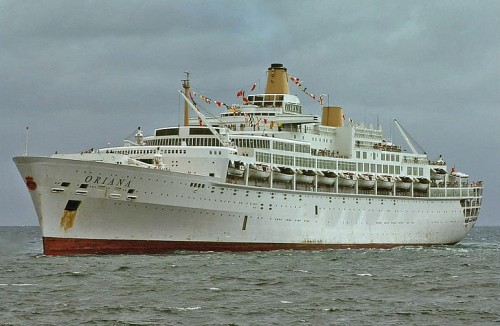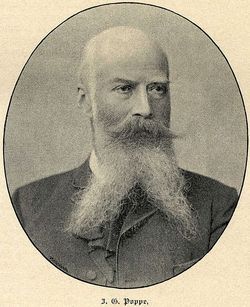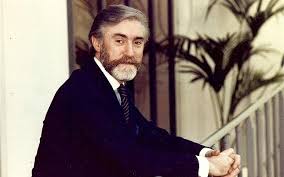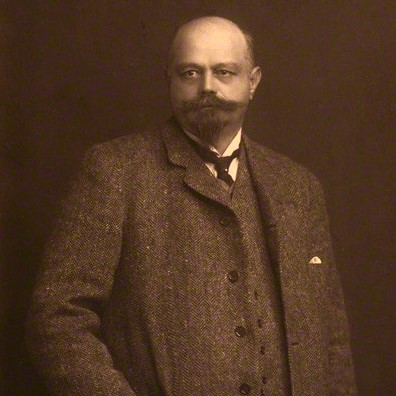In 1957 Orient Line (short for Orient Steam Navigation Company) ordered a new flagship, their largest yet. Like more passenger ships built at the time, she was designed with both liner service and cruising in mind. Her building price was 14 million pounds. During the design phase, her intended name was Orbustus. Her superstructure was built in aluminium, her keel was laid on September 18, 1957 at the Vickers-Armstrong yard and at the time she was the largest passenger ship built in England. She was designed by Orient Line’s Charles F. Morris, one of thier leading naval architects. Capable of 27 knots she was a fast ship. The fastest ship of the P&O-fleet was awarded the Golden Cockerel and Oriana as the ship was ultimately named, retained it until she was withdrawn and it was passed on to the Canberra, which had always been te slower of the two.

Orient Lines had been thinking of building a vessel of around 28,000GRT with a speed of 22.5 knots or ordering a much faster ship that could make 27 knots. This would reduce a round trip England – Australia -New Zealand by about a fortnight, thus saving more than enough operating costs to justify the extra building costs.

HRH Princes Alexandra launched her in November 1959 and named her Oriana, meaning Dawn in latin. Oriana was also a reference to Queen Elizabeth I’s nickname. Further outfitting and trials during which she reached a maximum speed of 30.64 knots followed. Finally, in December 1960 she left Southampton on her maiden voyage to Australia. It took her 24 days to reach Melbourne. Until Canberra was introduced she was the largest vessel on the route. A year later she did 27 knots after departing Auckland for Sydney and set a new record. When she passed through the Panama Canal in July 1961, she was the largest vessel since the ss Bremen in 1938 to do so. In 1962 she collided in dense fog with the US air carrier USS Kearsarge and both ships suffered hull damage. It led to a fight in court to establish which ship was at fault. Two years later in 1964 again a record was set between Auckland and Sidney, she reached 27.76 knots. Oriana was transferred to P&O Lines after the merger (P&O and Orient Line had meged in 1960) and her corn coloured hull was repainted to white.

Unfortunately in 1969 Oriana suffered some damage when she struck a wall of one of the Panama Canal locks and she damaged one of her propellors. A year later again problems arose when a fire broke out in the boiler room just after leaving Southampton for yet another voyage down-under. She was towed back and repaired in two weeks. Starting in 1973, her capacity was changed to 1677 passengers in one class and she switched to full time cruising from November to January out of Sydney and the remainder of the year from Southampton.

In 1978 an anonymous letter was received at P&O headquarters with the message that a bomb had been placed onboard Oriana. A bomb squad was sent out to the ship, but the crew had already conducted a thorough search and nothing was found so they could return home. In 1981 P&O decided to withdraw Sea Princess from South Pacific cruise service out of Sydney and Oriana replaced her. Four years later P&O announced Oriana would be witdrawn from service too and in March 1986 she was laid up in Sydney at no.21 Pyrmont Wharf. Just two months later she was refitted st the Hitachi Zosen yard for a stationary role as a museum, hotel and tourist centre, having been sold to Japanese interests. Her propellors and rudder were removed and in August that year she was moored at Oita, near Beppu, a resort on the island of Kyushu, Japan. Her funnels were painted pink.

The Chinese Hangzhou Jiebai Group, owner of a chain of department stores bought her in 1995 and she was relocated to Qinhuangdao in China for use as a floating hotel. Three years passed by and again a change of ownership, now she was sold to Hangzhou West Lake Int. Tourisme Cultural Delopment Co. for $6 mio. and towed to Shanghai. There she was again refitted and new elevators and airconditioning was installed. She was advertised as “maintaining her British style, keeping original furniture and artefacts in place”. Almost $4 mio.was spent on upgrading her and she opened February 1999 as a floating hotel complete with a swimming pool, wedding chapel, miniature golf course and a 20,000 sq m exhibition hall. Now located on the Huangpu River at Shanghai, 3000 visitors board her daily. A year later, Oriana had received half a million visitors but her owners stated she had made a loss of a quarter of a million dollars….

In 2001 reports were confirmed that she was sold yet again, this time for $4 mio. Again she would be refitted prior to her new role as a museum, banquet hall and theme aprk in the Chines port of Dalian. The Huanghzou Sonhcheng Group is said to have invested $400,000 in refitting the ship in 2001 after they had acquired her. The only original parts of Oriana now still remaining are the bridge, post-office, VIP-hall , hospital and some spaces that had been turned into a museum. Alas in 2004, one of the worst storms to have ever hit the region severely damages Oriana and she heels over, partly submerged. Being too heavily damaged to be repaired, in June 2005 four tugs delivered her to a Chinese scrapyard.
In 1995 P&O honoured Oriana of 1960, the last Orient Line liner, by naming their new cruise ship, replacement for the Canberra, Oriana.






